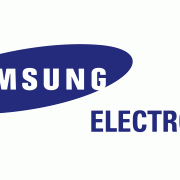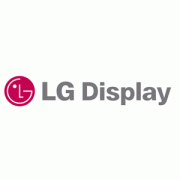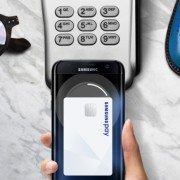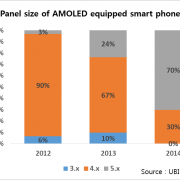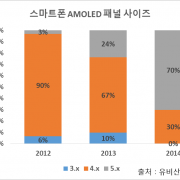글
Samsung Electronics, sets a profit record of 0.97 Trillion Won in the 3rd Quarter
/0 코멘트/카테고리: Uncategorized /작성자: OLEDNETSamsung Electronics reported sales of KRW 62.05 trillion and operating profit of KRW 14.53 trillion through the conference call of the third quarter in 2017, and the display business recorded sales of KRW 8.28 trillion and operating profit of KRW 0.97 trillion. Display business sales increased 7.4% compared to the previous quarter and 17.3% compared to the previous year, but operating profit of 1 trillion fell with a decrease of 43.3% of the previous quarter and 4.9% the previous year. OLED sales are shown to occupy 60% of the display industry.
According to Samsung Electronics, in the 3rd quarter of 2017, main customers of OLED have increased through the launch of new flagship products focused on flexible products. However, its performance has decreased than the previous quarter due to factors such as increased costs of new OLED lines initial ramp-ups, and intensified price competition between rigid OLEDs and LCD panels.
Samsung Electronics plans to increase supply of flexible products in OLED in the 4th quarter, and expand sales of rigid OLED products to secure profitability. In the LCD industry, there are off-seasons and excess supplies resulting to supply and demand imbalance, but profitability is to be secured by strengthening yield and cost activities and expanding sales portion of high value-added products such as UHD, large-format, and QD.
In 2018, OLEDs are expected to become the mainstream in the mobile display market, with expectations that flexible panel dominance will be particularly strong in the high-end product line. Samsung Electronics said it plans to develop a system to meet the flexible demand of major smartphone manufacturers and improve earnings by securing differentiated technologies.
In 2018, the LCD market may continue to expand in China and intensify competition among companies, but trend of large-sized and high-resolution TVs are expected to continue. Samsung Electronics states it will strengthen its strategic partnership with its customers and concentrate on improving profitability by promoting sales of high value-added products such as UHD, large format, QD, and frameless products.
Samsung Electronics sold 97 million mobile phones and 6 million tablets in the 3rd quarter of 2017. Mobile phone sales in the 4th quarter are expected to decline Quarter on Quarter, but tablet sales are expected to increase QoQ. TV sales reached a record around 10 million units, and sales in the 4th quarter were expected to rise to mid-30%.
10.4 trillion was invested in facility during the 3rd quarter of Samsung Electronics, of which 2.7 trillion was invested in display. Displays are reported to have additional production lines to meet customer demands for flexible OLED panel.
CEO Chang-Hoon Lee of Samsung Display said, “In the case of small and medium-sized OLEDs, we are planning to apply it to AR, VR, foldable, and automotive industry.” Also, “In Automotives, OLEDs are focused on energy efficiency, design differentiation, and black image quality which is critical to driver safety, in preparation with client company cooperation.” Additionally, “Foldable is constantly being researched and developed in line with customer demand, and is centered on enhancing the level of perfection demanded by the market and customers. We will work with our clients to prepare these for mass production desired by our customers.”
삼성전자, 3분기 디스플레이 사업 영업이익 0.97조원 기록
/0 코멘트/카테고리: 디스플레이 /작성자: OLEDNET삼성전자는 31일 진행된 2017년 3분기 실적 컨퍼런스콜을 통해 매출 62.05조원, 영업이익 14.53조원을 기록했으며, 이 중 디스플레이 사업에서 매출 8.28조원, 영업이익 0.97조원을 기록했다고 밝혔다. 디스플레이 사업 매출은 전분기 대비 7.4%, 전년 동기 대비 17.3% 증가했지만, 영업이익은 1조원대가 무너지며 전분기 대비 43.3%, 전년 동기 대비 4.9% 감소했다. 디스플레이 사업에서 OLED 매출은 60% 후반의 비중을 차지했다고 밝혔다.
삼성전자에 따르면 2017년 3분기에는 OLED 부문에서 주요 고객사의 플래그십 신제품 출시로 flexible 제품을 중심으로 매출이 증가했다. 하지만 신규 OLED 라인 초기 ramp-up에 따른 비용 증가, rigid OLED와 LCD 패널 간의 가격 경쟁 심화 등의 영향으로 전분기 대비 실적이 감소했다고 설명했다. LCD 부문은 주요 고객의 재고 조정 등에 의해 판가 하락 영향으로 실적이 약화되었고 밝혔다.
삼성전자는 4분기 OLED 부문에서 flexible 제품의 생산성을 높여 공급을 본격적으로 확대하고, rigid OLED 제품 판매를 확대해 수익성을 확보할 계획이다. LCD 부문의 경우 계절적 비수기와 업계의 공급 초과 상황이 지속되어 수급 불균형의 우려가 있으나, 수율과 원가 개선 활동을 강화하고, UHD, 대형, QD 등의 고부가 제품 판매 비중을 확대해 수익성 확보에 주력할 방침이라고 밝혔다.
2018년에 OLED는 모바일 디스플레이 시장에서 mainstream이 될 것으로 기대되며, 특히 high-end 제품군에서 flexible 패널의 지배력 강화가 전망된다고 밝혔다. 삼성전자는 주요 스마트폰 업체들의 flexible 수요에 적기 대응할 수 있는 시스템을 구축하고, 차별화된 기술 확보를 통해 실적 개선을 추진할 계획이라고 설명했다.
2018년에 LCD 시장은 중국의 생산량 확대가 지속되고 업체간 경쟁도 심화되지만, TV의 대형화와 고해상도 트렌드 또한 지속될 것으로 전망된다고 밝혔다. 삼성전자는 고객사와의 전략적 파트너십을 견고히 하고, UHD, 대형, QD, frameless 등 고부가 제품과 디자인 차별화 제품의 판매 확대를 추진해 수익성 제고에 집중할 방침이라고 밝혔다.
삼성전자는 2017년 3분기에 휴대폰 9,700만 대, 태블릿 600만 대의 판매량을 기록했다. 4분기 휴대폰 판매량은 전분기 대비 감소할 것으로 예상하지만, 태블릿 판매량은 전분기 대비 증가할 전망이라고 밝혔다. TV의 판매량은 약 1,000만대를 기록했으며, 4분기 판매량은 30% 중반대의 상승을 예상했다.
삼성전자의 3분기 시설 투자는 총 10.4조원이 집행되었고, 이 중 디스플레이에 2.7조원이 투자됐다. 디스플레이의 경우는 flexible OLED 패널 고객 수요에 대응하기 위한 생산라인 증설 투자가 진행중이라고 설명했다.
삼성디스플레이 이창훈 상무는 “중소형 OLED의 경우 현재 주력인 스마트폰 외에도 AR, VR, foldable, automotive 등에 확대 적용할 예정”이라고 설명했다. 이어 “Automotive에서는 OLED가 에너지 효율, 디자인 차별화, 운전자의 안전에 중요한 블랙 화질 구현 등의 장점으로 관심이 집중되고 있어 앞으로 고객사와 협력을 통해 준비하겠다”고 설명했다. 또한, “Foldable은 고객 수요에 맞춰 지속적으로 연구, 개발 중이며 시장과 고객이 원하는 수준의 완성도 제고에 중심을 두고 있다. 고객사와 협력을 통해 고객이 원하는 시점에 양산 가능하도록 준비하겠다”고 덧붙였다.
LG디스플레이, 2018년 OLED 매출 비중 2배로 확대
/0 코멘트/카테고리: 디스플레이 /작성자: OLEDNETLG디스플레이는 25일 진행된 3분기 실적 컨퍼런스 콜을 통해 2018년까지 OLED 매출 비중을 10%에서 20%로, 2배 확대할 예정이라 밝혔다.
LG디스플레이 김상돈 전무는 ‘대형 OLED 생산 capa. 확대를 통해 OLED TV 출하량이 증가하고 있고, wallpaper와 CSO(crystal sound OLED) 등 프리미엄 신제품 등이 좋은 반응을 얻고 있다’며, ‘LCD TV와의 차별성이 인정되고 있다’고 설명했다.
이에 따라 ‘2017년 OLED TV 패널 출하량은 170만대로 예상하고 있다’며, ‘2018년에는 출하량이 250만~280만대, 2020년에는 650만대 이상이 될 것으로 기대하고 있다’고 말했다.
LG디스플레이는 ‘OLED 패널의 수익성을 확보하기 위해 경제적인 규모를 늘리고 있다’고 설명했다. 동시에 ‘재료비와 제반비를 줄이기 위해 중국에 OLED 패널 공장을 짓고, 효율적인 라인과 규모의 경제, eco system 확대 등을 통해 원가를 절감할 것’이라 덧붙였다.
2017년 4분기 출하 면적은 ‘연말 및 내년 춘절 등 성수기 대응 영향에 힘입어 한자리 수 중반 증가하고, 판가는 제품별, 사이즈별 수급 상황에 따라 차이는 있겠지만 전반적으로 하락할 것으로 예상되나 하락세는 점차 둔화될 것’이라 전망했다.
모바일용 디스플레이에 대해서는 현재 ‘LCD에서 POLED로의 전환되고 있다’며, ‘LCD패널의 매출이 전체 매출의 30%를 차지하고 있으나, 2019년 투자가 완료되는 시점에서 매출이 본격적으로 이루어질 것’이라 설명했다.
이어 ‘LG디스플레이는 장기적 미래 준비 계획으로 향후 OLED 중심의 투자를 진행할 예정인 가운데, 어려운 시장 환경이 지속될 수 있다는 보수적인 기조 하에 LCD 차별화 제품 위주의 수익성 극대화 및 OLED 사업 확대를 통한 수익성 개선 노력을 지속하겠다’고 덧붙였다.
한편, LG디스플레이는 판가 하락세 지속에도 불구하고 2017년 3분기 기준 매출 6조 9,731억원, 영업이익 5,860억원으로 22분기 연속 영업이익 흑자를 달성했다. 매출은 OLED TV 제품 확대 등 프리미엄 제품 강화 및 계절적 성수기에 따른 중소형 모바일 제품 출하 증가 영향으로 전분기 6조 6,289억원 대비 5%, 전년 동기 6조 7,238억원 대비 4% 증가했다.
2017년 3분기 매출액 기준 제품별 판매 비중은 TV용 패널이 40%, 모바일용 패널이 27%, 노트북 및 태블릿용 패널이 17%, 모니터용 패널이 16%를 차지한 것으로 나타났다.
LG전자,‘G5′ 한국 등 200개국 출시
/0 코멘트/카테고리: 세트 /작성자: OLEDNET강현주 기자 / jjoo@olednet.com

Source : LG전자
LG전자는 ‘G5’를 오는 31일 한국시장을 시작으로 미국, 유럽, 중국 등 전 세계 200여개 이동통신사를 통해 순차적으로 출시할 예정이다. 국내 출시가격은 83만 6천원이다.
LG전자는 오는 4월 15일까지 ‘G5’를 구매하는 국내고객에게 카메라 그립 모듈 ‘캠 플러스’와 ‘배터리팩(추가 배터리+충전 크래들)’을 무료로 증정한다. ‘B&O 패키지’도 할인가격으로 제공한다. ‘B&O 패키지’는 고품질 오디오 모듈 ‘하이파이 플러스’와 프리미엄 이어폰 ‘H3 by B&O PLAY’로 행사기간 동안 약 38% 할인된 289,000원에 구매할 수 있다. 사용자는 ‘G5’에 탑재된 ‘기프트팩’ 애플리케이션을 통해 사은품을 신청할 수 있다.
LG전자는 31일 ‘G5’와 함께 ‘캠 플러스’, ‘하이파이 플러스’, ‘360 VR’, ‘360 캠’, ‘H3 by B&O Play’, ‘톤 플러스(HBS-1100)’ 등 ‘프렌즈’ 6종도 함께 출시한다.
‘프렌즈’는 LG 베스트샵과 하이마트 등 오프라인 매장은 물론, 프렌즈 온라인 쇼핑몰(http://kr.lgfriends.com)에서도 구매할 수 있다.
LG전자의 프리미엄 스마트폰 라인업 ‘G시리즈’의 5번째 모델인 ‘G5’는 세계 최초로 디바이스간 결합을 지원하는 ‘모듈 방식(Modular Type)’을 적용, 글로벌 미디어로부터 스마트폰의 무한한 확장 가능성을 제시했다는 평을 들었다.
LG전자는 고객들이 ‘G5와 프렌즈’를 직접 만져보고 경험할 수 있는 체험존을 신사동 가로수길, 영등포 타임스퀘어, 삼성동 코엑스 등에서 운영 중이다. 또, 31일 오후 7시부터 서울 강남에 위치한 클럽 ‘옥타곤’에서 약 2천명의 일반소비자를 초대, G5 런칭파티인 ‘Dream Players with G5 & Friends’를 연다.
LG전자 대표이사 MC사업본부장 조준호 사장은 “‘G5’와 ‘프렌즈’는 지난 2월 공개 이후 전 세계 소비자들로부터 긍정적인 평가를 받고 있다”며, “모바일 시장에 새로운 패러다임을 제시할 것”이라고 강조했다.
삼성전자, 중국에서 ‘삼성 페이’ 서비스 시작
/0 코멘트/카테고리: 세트, 세트, 포커스온 /작성자: OLEDNET강현주 기자 / jjoo@olednet.com
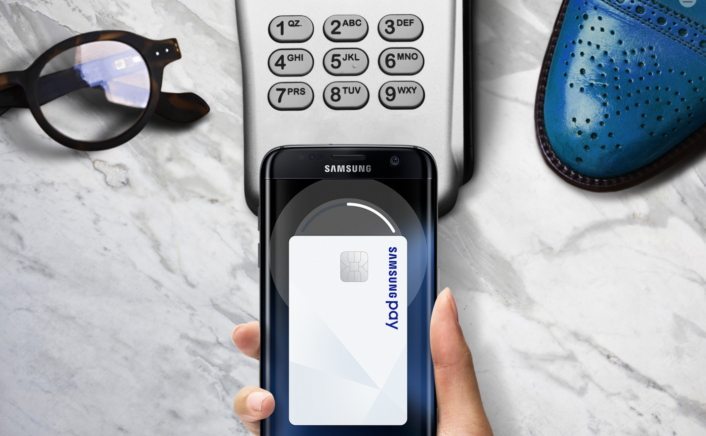
<출처 : 삼성전자>
삼성전자가 중국에서 ‘삼성 페이’ 서비스를 시작한다고 29일발표했다. 삼성페이는 이날 부터 중국의 유니온 페이와 손잡고 중국에서 ‘삼성 페이’ 서비스를 시작한다.
모바일 결제 서비스 ‘삼성 페이’는 중국 전역에서 유니온 페이의 신용카드와 체크카드를 모두 지원할 예정이다. ‘삼성 페이’는 현재 공상 은행, 건설 은행, 중신 은행 등 중국 내 주요 9 개 은행의 신용 카드와 체크 카드를 지원하며, 중국 은행, 북경 은행 등 6 개 은행이 추가될 예정이다.
중국 ‘삼성 페이’는 ‘갤럭시 S7 엣지’, ‘갤럭시 S7’, ‘갤럭시 S6 엣지+’, ‘갤럭시 노트 5’ 등을 통해 사용이 가능하며, 향후 지원 가능한 다양한 제품이 지속 출시될 예정이다. 또한, 중국 소비자들에게 더 많은 혜택과 서비스를 제공하기 위해 유니온 페이를 포함한 다양한 파트너사들과 협력을 더욱 강화하고, 중국 모바일 결제 시장의 혁신을 주도 할 예정이다.
삼성전자 무선사업부 이인종 부사장은 “유니온 페이와의 협력을 통해 중국에서 삼성 페이 서비스를 시작하게 되어 대단히 기쁘게 생각한다”며 “삼성 페이는 한국과 미국에 출시된 이후 많은 소비자들의 사랑을 받고 있으며, 사용 빈도와 금액 모두 매우 성공적”이라고 말했다. 그는 “중국의 더 많은 소비자들이 안전하고 편리하게 삼성 페이를 즐길 수 있도록 노력하겠다”고 덧붙였다.
유니온 페이 후잉 부총재는 “유니온 페이는 중국과 해외에 있는 수백만 명의 고객들에게 안전하고 편리한 모바일 결제 서비스를 제공하기 위해 지속적으로 노력해 왔다”며 “이번에 삼성전자와 함께 시작하는 ‘삼성 페이’ 서비스를 통해 보다 안전하고 편리한 모바일 결제가 가능해 질 것”이라고 말했다.
Samsung Pay is now available in China
/0 코멘트/카테고리: /작성자: OLEDNETHyunjoo Kang / Reporter / jjoo@olednet.com

<Source : Samsung Elec.>
Samsung Electronics and China UnionPay (CUP) announced the launch of Samsung Pay in China. A simple, safe and easy-to-use mobile payment service, Samsung Pay works virtually anywhere you can swipe or tap your card in China. Samsung Pay will enable users to safely manage and use their debit and credit cards on eligible Samsung mobile phones with CUP.
“We are pleased to be partnering with CUP to bring Samsung Pay to China,” said Injong Rhee, EVP and Head of R&D, Software and Services of Mobile Communications Business at Samsung Electronics. “The reception of Samsung Pay since its launch has been extremely positive and the service has already seen tremendous success in terms of availability and adoption by consumers. In compliance with national laws and regulations, thanks to cooperating with CUP and many banks, we ultimately want to make Samsung Pay available to as many consumers as possible in china, so that everyone can have the opportunity to enjoy the simplicity, safety and convenience of this mobile payment solution.”
“China UnionPay attaches great importance to the security and innovation of payment. In order to follow the tendency of mobile payment in both China and abroad, CUP cooperates with industry to bring safe and convenient mobile payment experience for millions card holders. With the joint efforts of banks and Samsung, based on the safety testing and certification by relevant national testing agency, CUP QuickPass starting Samsung Pay service will bring users safer and more convenient mobile payment choice.” said Hu Ying, Assistant President of UnionPay.
Samsung Pay is currently available on the Samsung Galaxy S7, Galaxy S7 edge, Galaxy S6 edge+ and Galaxy Note5 in China with the opportunity to support additional mid-range models in the future.*
Samsung Pay currently supports select credit and debit cards from nine banks including China CITIC Bank, China Construction Bank, China Everbright Bank, China Guangfa Bank, China Minsheng Banking Corp. Ltd, China Merchants Bank, Hua Xia Bank , Industrial and Commercial Bank of China and Ping An Bank**
Samsung Pay will eventually include future support for select credit and debit cards from six additional banks including Bank of China, Bank of Beijing, Bank of Communications, China Bohai Bank, Industrial Bank and Shanghai Pudong Development Bank. Samsung Pay continues to strategically expand its partnership ecosystem to provide greater flexibility, access, and choice for customers.
To make a payment with Samsung Pay, consumers simply swipe up from Home bottom whether the phone screen is locked, going black or in home screen, scan their fingerprint and pay, which is quite easy and convenient. In term of safety, Samsung Pay has three layers protection, which are fingerprint authentication, tokenization and KNOX. Because of innovative technology, Samsung Pay can be used on both QuickPass POS terminal with NFC and more POS terminals without NFC technology, which is more accepted than other similar applications with only NFC technology.
LG전자, ‘UX 5.0’ 공개…G5에 첫 탑재
/0 코멘트/카테고리: 포커스온, 포커스온, 포커스온, 포커스온 /작성자: OLEDNET강현주 기자 / jjoo@olednet.com
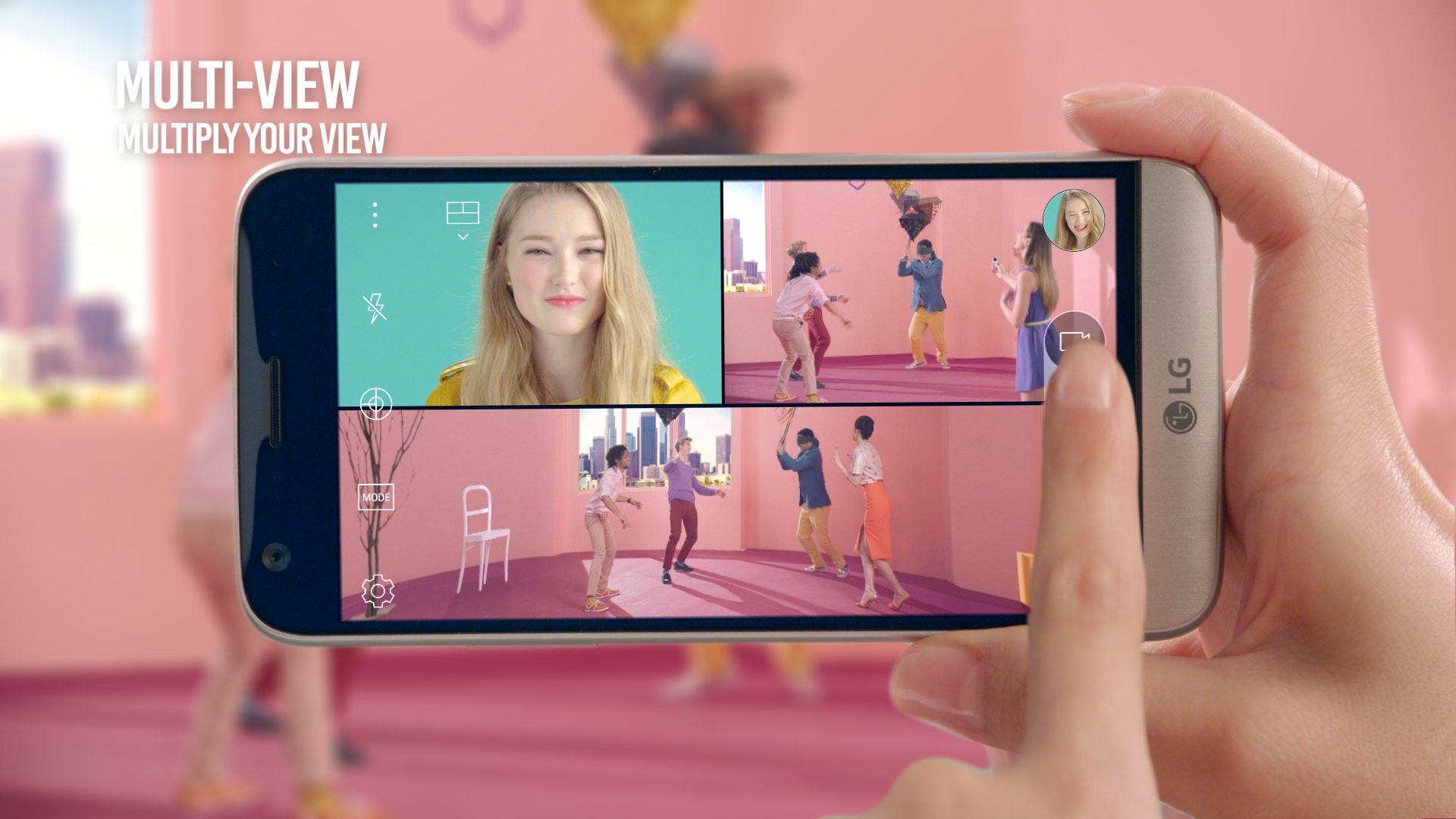
출처: LG전자
LG전자가 ‘LG UX 5.0’을 공개,‘G5’에 가장 먼저 탑재하고 이후 출시하는 다른 모델에도 순차 적용할 예정이다.
LG전자는 ‘G5’에 세계 최초로 기기끼리 결합할 수 있는 ‘모듈 방식’을 적용해 스마트폰의 무한한 확장 가능성을 제시했다. G5는 주변기기인 ‘LG 프렌즈’와 결합한다.
LG전자는 ‘UX 5.0’를 통해 ▲‘프렌즈’와의 쉬운 연동 ▲비주얼 향상 기능 ▲편의성 강화 등을 구현했다고 설명한다.
‘UX 5.0’의 ‘LG 프렌즈 매니저(LG Friends Manager)’는 다양한 ‘프렌즈’를 ‘G5’와 쉽게 연동하고 제어할 수 있는 통합관리 앱이다.
‘프렌즈 매니저’는 주변의 ‘프렌즈’를 자동으로 인식해 복잡한 절차 없이 연결할 수 있다. 사용자는 G5에 선탑재 된 ‘프렌즈 매너저’를 통해 각 프렌즈의 전용앱을 쉽게 설치할 수 있다.
‘G5’는 360 캠, 롤링봇 등 다양한 프렌즈와 연결해 사진을 찍으면 ‘G5’ 카메라 앨범에서 사진을 모아 볼 수 있다. 사용자는 ‘프렌즈’로 찍은 사진을 찾거나 관리할 수 있다.
LG전자는 ‘G5’에 비주얼 기능을 강화한 카메라 UX를 탑재했다. ‘오토 셀피(Auto Selfie)’는 셀피 촬영 시 사용자가 별도의 버튼을 누르거나 특정 제스처를 취하지 않아도 스마트폰이 사용자의 얼굴을 인식해 자동으로 촬영하는 기능이다. 스마트폰이 사용자의 얼굴을 인식한 후 화면의 움직임이 없으면 1초 뒤 자동으로 촬영된다. ‘오토셀피’는 소비자들의 큰 호응을 얻었던 손바닥을 편 상태에서 주먹을 쥐면 셀피가 찍히는 ‘제스처샷’에서 한 단계 진화한 셀피 UX다.
‘멀티뷰’는 G5의 전후면 3개의 카메라를 이용해 동시에 각기 다른 사진이나 영상을 한 화면에 분할해 담을 수 있는 기능이다. 특히 사용자가 ‘G5’를 ‘LG 360 캠’과 연결하면 ‘G5’의 카메라뿐 아니라 ‘360 캠’으로 찍은 이미지까지도 한 화면에 담을 수 있다.
‘팝아웃 픽처’는 2개의 후면 카메라로 동시에 촬영한 사진을 한 화면에 겹쳐 보여주는 기능이다. 사용자는 광각 카메라로 찍은 부분을 흐리거나 흑백으로 만들어 일반각으로 찍은 장면이 마치 액자 안에 있는 듯한 색다른 사진을 얻을 수도 있다. 광각카메라로 찍은 사진은 흑백, 비네트, 흐림 등 효과를 줄 수 있다. 각 효과는 중복해 적용 가능하다.
‘필름 효과’는 필름 카메라 특유의 감성을 느낄 수 있는 스마트폰 사진 필터다. 사용자는 사진을 찍기 전에 ‘필름 효과’가 적용된 화면을 미리 보고, 자신이 원하는 색감을 선택할 수 있다.
LG전자는 ‘LG G5’에 스마트폰 최초로 탑재한 135도 광각 카메라를 보다 직관적으로 이용할 수 있도록 ‘줌인앤아웃’을 적용했다. 사용자들은 두 손가락을 모으거나 펼치는 동작만으로 일반각과 광각을 자연스럽게 전환할 수 있어 마치 하나의 렌즈처럼 사용할 수 있다.
사용자는 ‘360 월페이퍼’ 기능을 통해‘360 캠’으로 찍은 이미지를 배경화면으로 설정하면 홈화면을 360 파노라마 뷰어처럼 볼 수 있다. 스마트폰을 상하좌우로 움직이면 스마트폰의 움직임에 따라 배경화면도 따라 움직인다.
‘UX 5.0’은 사용자들이 앱 설치와 제거를 직관적으로 할 수 있도록 ‘홈 스크린’ 화면과 ‘앱 서랍’ 화면을 하나로 통일했다. 이를 통해 앱을 설치하거나 삭제할 때 사용자의 혼란을 최소화하고 앱 진입 경로도 단순화 했다. 기존 방식에 익숙한 사용자는 홈 설정에서 기존 방식의 홈화면을 다운받아 사용할 수 있다.
‘LG 헬스’는 사용자의 활동량을 체크해 ‘일반(Beginner) 모드’나 ‘프로(Advanced) 모드’로 나눠주며 각 모드에 적합한 운동 데이터를 제공한다. 일반모드 사용자의 운동량이 일정 수준으로 넘어서면 자동으로 프로모드로 전환된다. 또 사용자의 활동량을 시각적으로 보여주고 도전과제를 지속적으로 업데이트 하는 등 사용자가 운동을 계속 할 수 있도록 도와준다.
‘UX 5.0’에는 사용자가 잘 사용하지 않는 앱이나 파일을 찾아서 정리해 주는 스마트 클리닝 기능에서 한층 더 발전한 ‘스마트 닥터’ 기능이 추가됐다. 스마트 닥터는 사용자의 습관을 분석해 예상되는 문제를 미리 진단하고 해결 방법을 알려 주는 지능형 스마트폰 관리 기능으로 스마트폰이 항상 최적의 상태를 유지할 수 있도록 도와준다. 예를 들어 배터리를 완전 방전한 후 교체하는 사용자에게는 ‘올바른 배터리 충전 습관’에 대해 안내를 해 주는 식이다.
‘세계시간’은 기준 도시의 시간을 변경하면, 등록된 다른 도시의 시간도 함께 연동해 바뀌는 것을 시각적으로 보여준다. 예를 들어 서울 시간을 오후 3시로 맞추면 뉴욕은 오전 1시, 런던은 오전 6시로 함께 변경된다.
‘LG 백업’은 이전 스마트폰과 NFC 태깅만으로도 데이터 전송을 할 수 있어 스마트폰끼리 연결할 때 복잡한 설정을 할 필요가 없다. ‘LG 백업’은 스마트폰에 저장된 사진, 메모 등을 백업해 다른 스마트폰으로 옮길 수 있는 기능이다. LG전자 스마트폰 뿐 아니라 타 제조사의 스마트폰에서도 사용이 가능하다.
‘파일 매니저’는 마치 PC처럼 파일을 관리할 수 있는 기능이다. 상단에 있는 파일 경로를 버튼화 해 파일 경로를 누르면 해당 폴더로 바로 이동할 수 있다. 문서, 영상, 이미지 등의 필터 검색 기능도 있어 원하는 파일을 빨리 찾을 수 있다.
‘올웨이즈온’은 화면이 꺼져 있어도 시간, 요일, 날짜, 배터리 상태 등 기본 정보는 물론 문자, SNS 등의 알림 정보를 24시간 디스플레이에 표시해 주는 기능이다.
LG전자는 ‘G5’에 고유의 보안 방식인 노크 코드와 함께 지문인식 기능도 탑재해 소비자가 원하는 방식을 선택할 수 있도록 했다.
LG전자 대표이사 MC사업본부장 조준호 사장은 “LG UX 5.0은 스마트폰 사용자의 라이프 스타일을 분석해 확장된 모바일 경험과 뛰어난 편의성을 제공한다”고 강조했다.
LG UX 5.0, Equipped to G5
/0 코멘트/카테고리: /작성자: OLEDNETHyunjoo Kang / Reporter / jjoo@olednet.com

Souece : LG Elec.
With the imminent consumer rollout of the new LG G5, LG Electronics (LG) will also be introducing a new version of its mobile user interface, LG UX 5.0. Designed for a more playful and innovative mobile experience, LG UX 5.0 will offer advanced features and greater convenience not only for LG G5 users but owners of upcoming smartphone models as well.
Based on Android’s latest Marshmallow OS, LG UX 5.0 conveys LG’s philosophy on the future of mobiles. LG UX 5.0 is an enjoyable, enhanced and user-centric UX that supports easy connection for optimal control of LG Friends and delivers a more convenient and powerful experience by adding new functions that allow users to enjoy the G5 to its maximum potential.
“We analyzed the lifestyle of smartphone users to provide a superior mobile experience and greatly expanded the usability with LG UX 5.0,” said Juno Cho, president and CEO of LG Electronics Mobile Communications Company. “LG UX 5.0 and G5 were designed to provide an innovative user experience that reflects the needs of our most demanding customers.”
An Enjoyable UX for Connecting with LG Friends
The highlight of LG UX 5.0 is LG Friends Manager, a versatile application that enables users to easily connect with and control the modules and accessories known as LG Friends. LG Friends Manager intuitively detects nearby accessories for easy pairing with LG G5, easily downloading and installing all the required apps from the Google Play Store. No hassles, no hunting. With LG Friends Manager, the process of connecting the LG G5 to its Friends couldn’t get any easier.
LG Friends Manager generates a different display for each LG Friend. When paired with the 360 CAM, the screen on the G5 will display photo previews and the available shooting modes. The Friends Camera Album in the Gallery enables users to categorize and manage images captured with LG Friends such as 360 CAM and Rolling Bot.
An Enhanced UX for a Powerful Visual Experience
The greatest advantage of LG UX 5.0 is its enhanced support for LG G5’s extremely powerful camera. Image and video capturing has never been so enjoyable with features such as:
Zoom In & Out – Seamlessly switch between the standard 78-degree lens to the 135-degree wide angle lens by simply pinching the screen.
Auto Shot – An enhanced version of Gesture Shot, take the perfect selfies with this smart feature which triggers the shutter as soon as the users’ face is recognized.
Multi View – Captures different angles of images at the same exact moment using the front and rear cameras of the G5 and the LG 360 CAM.
360 Wallpaper – Images taken with the LG 360 CAM can be displayed as a 360 panorama, shifting in sync with movements of the G5.
Pop-out Picture – Combine two images taken simultaneously with the standard and wide angle lens to create a picture-in-a-frame effect.
Film Effect – Raise the level of effects with this set of filters that deliver an “analog” feel to photos. Use Camera Preview to preview and change a filter on the fly before taking the shot.
A User-Centric UX for Greater Convenience
LG refined its user interface and included several new smart features on LG UX 5.0 to enhance usability and convenience, such as:
New Home – LG combined its Home Screen with the App Drawer in LG UX 5.0 to simplify the user experience. Users who prefer the traditional style can download the Home & App Drawer directly from the settings menu on the LG G5.
LG Health – Upgraded for UX 5.0, LG Health provides a Beginner as well as Advanced mode matched to the user’s profile. Start with Beginner and switch to Advanced once your activities reach a certain level, staying motivated along the way with visual details of your progress.
Always-on – Avoid the hassle of turning on the smartphone display just to check the time. With Always-on, all your key information including the date, notifications and SMS icon are displayed on the screen at all times.
Smart Doctor – Keep your G5 performing at its optimal level with solutions and tips based on your usage habits.
World Clock – Enhanced with an attractive graphical user interface, this smart clock displays the time in selected cities around the world and immediately syncs them to whatever local time you set for easy scheduling of phone calls and meetings.
File Manager – Navigate the G5 as easily as navigating your PC with direct access to any folders or files indicated by the directory path at top. Use the new search filter to find documents, videos and images anywhere on your G5.
Quick Help – Find answers to any questions about the G5 quickly and easily or request feedback by e-mail.
LG Backup – Use LG Backup and NFC to restore conveniently from other Android phones and now record conversations from your favorite messenger app.
Diverse Security Method – In addition to LG’s familiar Knock Code, accurate fingerprint recognition is now built into LG UX 5.0 to provide added convenience and security.
[Analyst Column] Encapsulation Technology, Where is it Going?
/0 코멘트/카테고리: /작성자: OLEDNETYi Choong Hoon Yi, Chief Analysis / UBI Research
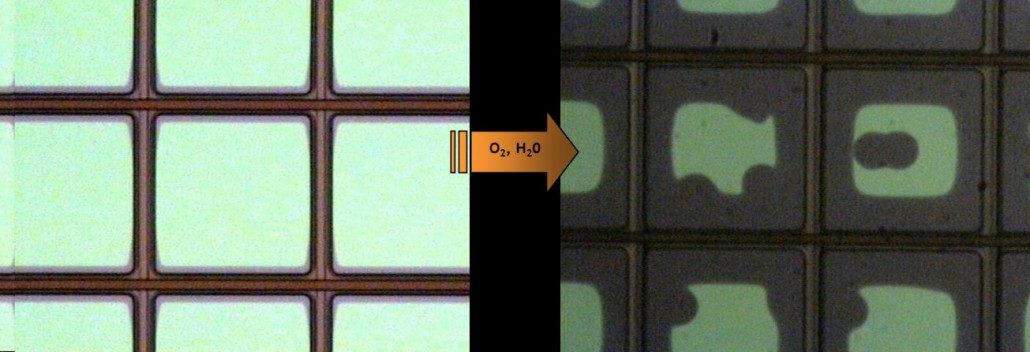
OLED market is heating up again. Rigid OLED market growth was temporarily stalled but with Samsung Electronics and LG Electronics’ new flexible (plastic) OLED products, Galaxy S6 Edge and G Flex 2 respectively, the smart phone market’s temperature is rising. In order to maintain the storm that iPhone brought, Apple is preparing to release smart watch equipped with LG Display’s plastic OLED. Additionally, LG Elec. is targeting the premium TV market with their 55 inch and 65 inch UHD OLED TV.
OLED panel leading company Samsung Display decided on Gen 6 line’s additional investment for flexible OLED production expansion. LG Display also decided on supplemental extension of Gen 4 line in Paju responding to the shortage of plastic OLED supply. Furthermore, JDI is joining in and expected to begin Gen 6 flexible OLED line establishment soon.
Recently announced Samsung Display’s decision to invest in large OLED line is the most encouraging news. Frontline leader in OLED display, Samsung Display mass produced 55 inch OLED panel using RGB OLED and LTPS TFT technology. However, halting the production, Samsung Display explored for technology with better business value and recently selected to produce large OLED panel using WRGB OLED technology.
OLED panel production technology can be largely separated into 3 parts: TFT, OLED, and encapsulation. Large OLED panel production technology is very difficult to obtain yield compared to small panel. Therefore, while the above 3 technologies are important in producing good panel, technology that can acquire good yield for mass production can guarantee business value. Particularly, as encapsulation is the last process, the final yield depends on the encapsulation method.
In that case, what encapsulation technology is most suitable for large area OLED panel production? As OLEDNET article published on January 12 mentions, from the technology trend perspective the answer is hybrid encapsulation technology. This technology is completed with device’s passivation film, moisture proof top plate that can cover the top, and organic material that adhere the top and passivation film. From the design trend perspective, the technology must be able to bend. Recently, the TV market is moving toward curved design, and to respond to rollable display as well the top plate has to be metal rather than glass. (Reference, 2015 OLED Encapsulation Report, UBI Research)
Hybrid encapsulation technology can be further divided into film method and dam & fill method depending on the adhesive structure between top plate and passivation film. Film method is being applied to mass production by LG Display, and dam & fill method was developed led by Sony. This method dispenses adhesive polymer liquid after organic dam installation on the panel border. This can only be used when the top plate is glass. LG Display completes the process by sealing the metal plate laminated with adhesive film to the device. A best suited technology for curved TV and rollable TV production.
The OLED panel for TV production technology decided by Samsung Display was initially known to select WRGB OLED structure similar to LG Display, but TFT and encapsulation technology have not yet been revealed. However, TFT technology is highly likely to be oxide TFT. (Reference February 27 OLEDNET article) LTPS TFT has high investment cost compared to oxide TFT and has low business value at similar performance.
What is left is encapsulation technology. For this technology also a method already commercialized by LG Display, film lamination method, is most suitable since metal plate is favorable for curved design. Metal plates is strong against external shocks and favorable for heat sink. Glass has lower heat conductivity compared to metal and requires additional protection against heat; this means that production cost can only increase. Considering design, protection against external shocks, and reduced heat sink cost, LG Display’s hybrid encapsulation technology that uses metal plate is the most ideal. Therefore, the direction that Samsung Display should also head toward is metal plate and film using method.
Although small OLED for mobile technology developed by Samsung Display became the norm, it is estimated that LG Display’s technology will become standard for large OLED panel production.
[Analyst Column] Encapsulation 기술, 어디로 가나?
/0 코멘트/카테고리: 애널리스트 칼럼 /작성자: OLEDNET이충훈, 유비산업리서치 수석 애널리스트

OLED 시장이 다시 달아 오르기 시작한다. Rigid OLED 시장 성장이 일시 제동이 걸려 있으나, 삼성전자와 LG전자는 flexible (plastic) OLED로 각각 Galaxy S6 Edge와 G Flex2를 내놓으면서 smart phone 시장에 다시 불을 지피고 있다. 또한 Apple은 iPhone 돌풍을 이어가기 위한 병기로 LG디스플레이가 생산하는 plastic OLED를 탑재한 smart watch를 출시 준비 중이다. 더불어 LG전자는 55인치와 65인치 UHD OLED TV로서 프리미엄 TV 시장 공략에 나섰다.
OLED 패널 생산 최대 기업인 삼성디스플레이는 flexible OLED 생산 확대를 위해 Gen6 라인 추가 투자를 결정하였으며, LG디스플레이 역시 plastic OLED 공급 부족에 대처하기 위해 파주에 Gen4 라인 보완 증설을 결정하였다. 여기에 JDI도 가세하여 Gen6 flexible OLED 라인 증설을 곧 추진할 예정이다.
가장 고무적인 것은 최근 언론에 공개된 삼성디스플레이의 대형 OLED 라인 투자 결정이다. OLED 산업을 최전방에서 리딩하고 있는 삼성디스플레이는 RGB OLED와 LTPS TFT 기술로서 55인치 OLED 패널을 양산하였으나 생산을 중단하고, 보다 사업성이 우수한 기술을 결정하기 위해 장고에 들어갔다, 최근에 WRGB OLED 기술로서 대형 OLED 패널을 생산하기로 결정하였다.
OLED 패널 제조 기술은 크게 3부분으로 나누어진다. TFT와 OLED, 마지막으로 encapsulation이다. 대형 OLED 패널 제조 기술은 소형 패널에 비해 수율 확보가 상대적으로 매우 어렵다. 따라서 상기 언급한 세가지 기술은 좋은 패널을 제작하기 위함도 중요하지만, 양산에서는 보다 양호한 수율을 확보 할 수 있는 기술이 사업성을 보장한다. 특히 encapsulation은 마지막 공정이기 때문에 최종 수율은 encapsulation 방식에 의해 결정된다.
그러면 대면적 OLED 패널 제조에 가장 적합한 encapsulation 기술은 무엇일까? 1월8일자 OLEDNET 기사에서 이미 언급한 바와 같이 기술 트랜드 관점에서 보면 hybrid encapsulation 기술이다. 소수의 passivation막과 상부를 덮을 수 있는 방습용 상부 기판, 그리고 상부 기판과 passivation막을 접착하는 유기재료로 이 기술은 완성된다. 디자인 트랜드 관점에서는 휘어질 수 있어야 한다. 최근 TV 시장이 curved 디자인으로 흐름이 바뀌고 있으며, rollable 디스플레이까지 대응하기 위해서는 상부 기판이 유리 보다는 금속이 필수적이다. (참조, 2015 OLED Encapsulation Report, UBI Research)
Hybrid encapsulation 기술에 사용되는 방식은 상부 기판과 passivation막을 접착하는 구조에 따라 다시 film 방식과 dam & fill 방식으로 분류된다. Film 방식은 LG디스플레이가 양산에 적용하고 있는 기술이며, dam & fill 방식은 Sony가 주도로 개발한 기술이다. 이 기술은 패널 외곽에 유기물로서 dam을 설치하고 접착성 고분자 액체를 도포하는 방식이다. 상부 기판이 유리일 경우에만 사용이 가능하다. LG디스플레이는 접착 필름이 라미네이션 된 금속판을 소자에 합착하여 공정을 완성한다. Curved TV와 rollable TV를 만들기에는 최적인 기술이다.
삼성디스플레이가 이번에 결정한 TV용 OLED 패널 제조 기술은 우선 LG디스플레이와 유사한 WRGB OLED 구조를 채택할 것으로 알려졌으나 TFT와 encapsulation 기술은 아직 공개되지 않았다. 그러나 TFT 기술은 역시 oxide TFT가 될 가능성이 높은 것으로 추정된다. (2월27일 OLEDNET 기사 참조) LTPS TFT는 oxide TFT와 비해 투자비가 높기 때문에 유사한 성능에서는 사업성이 매우 낮기 때문이다.
남은 것은 encapsulation 기술이다. 이 기술 역시 이미 LG디스플레이가 상용화하고 있는 필름 라미네이션 방식이 최적이다. Curved 디자인에 유리한 금속판을 사용하는 것이 정답이기 때문이다. 금속판을 사용하면 외부 충격에도 강하며 방열에도 유리하다. 유리는 금속에 비해 열전도율이 낮아 금속판을 사용하는 기술에 비해 추가적인 방열 재료가 요구되므로 제조 비용이 상승할 수 밖에 없기 때문이다. 디자인 요소와 외부 충격 완화, 방열비용 절감을 위해서는 LG디스플레이가 사용하는 금속판을 사용하는 hybrid encapsulation 기술이 가장 이상적인 기술이다. 따라서 삼성디스플레이가 가야 할 기술 방향 역시 금속판과 필름을 사용하는 방식이다.
모바일용 소형 OLED 기술은 삼성디스플레이가 개발한 방식이 텍스트가 되었지만, 대형 OLED 패널 제조 기술은 LG디스플레이 기술이 텍스트가 될 것으로 전망된다.
[Analyst Column] AMOLED equipped smartphone promotes enlargement of the display on mobile device
/0 코멘트/카테고리: Uncategorized, Uncategorized, Uncategorized, Uncategorized /작성자: OLEDNETAccording to the “2015 OLED Display Annual Report” published by UBI Research, it was researched that the 5-inch AMOLED display is the main product for a smartphone.
The report shows almost no fluctuation in the number of AMOLED equipped smartphone manufacturers for the last three years from 2012 to 2014 – 13 (2012), 11 (2013) and 14 (2014) – but the major smartphone display size that these companies sold was set in-between 4-inch and 5-inch.
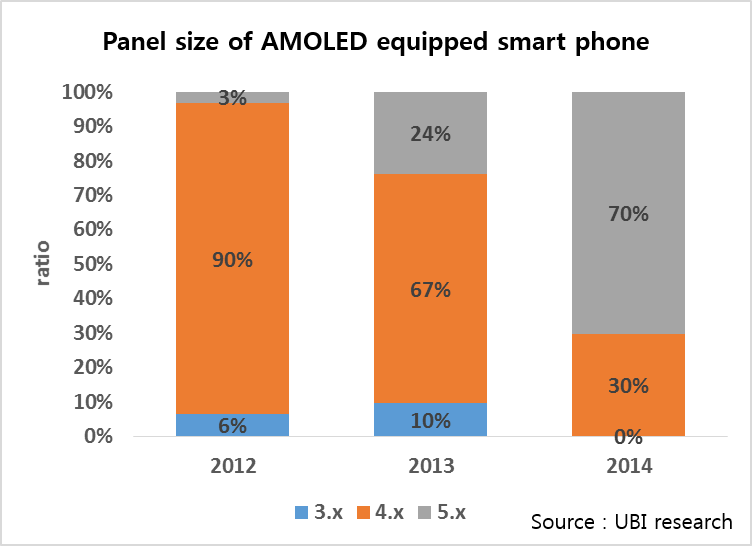
Among 31 AMOLED equipped products, there was only one 5-inch smartphone accounting for 3 percent in 2012, but it has increased to 21 percent with 5 products among 21 in 2013, and 19 products in total of 27 forming 70 percent in 2014.
Samsung Electronics strategized the two elements which are not available in iPhone as points of differentiation to compete with the biggest smartphone rival company Apple. The first plan is targeting the color gamut of LCD. The existing LCD can only reproduce approximately 80% of NTSC which is the broadcasting standard. Although it became possible to enjoy TV and movies through a smartphone with the development of communication technologies, there is a difficulty in reproducing the 500nit of TV quality on a smartphone with the brightness of 200nit. The limit in increasing the brightness of a smartphone is in that the power consumption needs to be minimized to use the smartphone for a long time with the battery. In view of that, Samsung Electronics chose the AMOLED panel as a key strategic part meeting the NTSC standard in low power consumption as an alternative for the LCD panel for the consumers to identify more precise colors. It is expected that the demand for AMOLED panel capable of accurately realizing colors of a product will increase further given the latest growth in shopping clothes with smartphones.
The second plan is in the display size. While iPhone focused on a 3-inch small sized smartphone for a better sense of grip to enhance portability, Samsung Electronics was more focused on “a product of better visibility” rather than “a product of better hand grip”. Obviously the early AMOLED panel has low resolution. Therefore, the bigger display was needed to realize high-resolution as it is hard to fix the opening ratio of shadow mask which is used in manufacturing the pixel for AMOLED panel.
Samsung Electronics succeeded in catching up with Apple, the inventer of smartphone, in terms of the color gamut and size of AMOLED display. Now Apple finally abandoned the matter of grip and expanded the display size to 5-inch.
Although Samsung Electronics was a latecomer compared to Apple in the smartphone market, the choice of AMOLED by Samsung Electronics made the Samsung Electronics of today and also prepared the base for the AMOLED to thrive. In addition, the Samsung Electronics’ strategy enabled the smartphone display in the world to develop into a 5-inch “device to see”.
Choong-hoon Yi, Chief Analyst/ UBI Research
[Analyst Column] AMOLED 탑재 스마트폰이 모바일용 디스플레이 대형화 주도
/0 코멘트/카테고리: 애널리스트 칼럼 /작성자: OLEDNET유비산업리서치가 발간한 “2015 OLED Display 연간 보고서”에 따르면 AMOLED 탑재 스마트폰의 디스플레이 사이즈가 5인치급이 주력 제품인 것으로 조사되었다.
본 보고서에 따르면 2012년에서 2014년 3년간 AMOLED 탑재 스마트폰 출하 업체 수는 13개사(2012년), 11개사(2013년), 14개사(2014년)로 변동폭이 거의 없으나, 이들 업체들이 판매한 스마트폰의 주력 디스플레이 사이즈는 4인치급에서 5인치급으로 자리 잡았다.
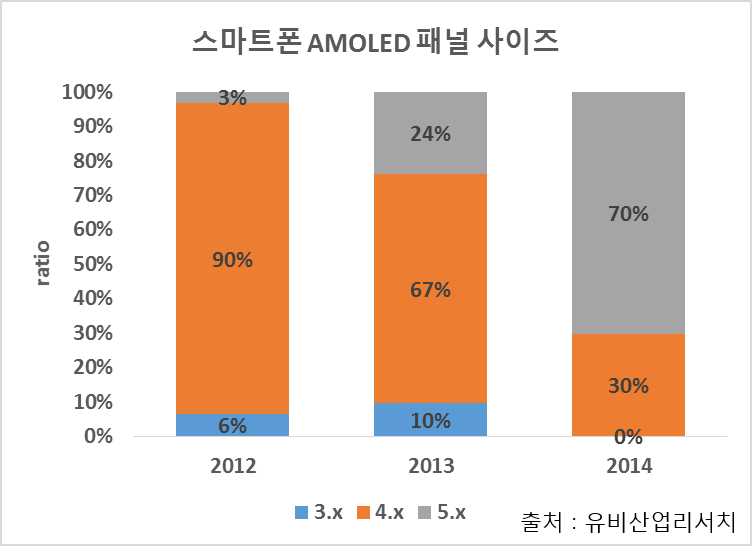
스마트폰 AMOLED 패널 사이즈
2012년에는 AMOLED 탑재 스마트폰 31개 제품 중 5인치급은 3%인 1개에 불과했으나 2013년에는 총 21개중 5개인 24%로 증가하였고, 2014년에는 27개 제품 중 19개가 5인치급이 사용되어 70%로 확대되었다.
삼성전자는 스마트폰 시장 최대 경쟁 업체인 애플과 경쟁하기 위해 iPhone에 없는 2가지 요소를 차별화 포인터로 전략화 시켰다. 첫째는 LCD의 색재현율을 공략한 점이다. 기존 LCD는 색을 표현하는데 있어 방송 기준인 NTSC의 약 80% 정도만 가능하였다. 통신 기술 발달에 의해 스마트폰에서도 방송과 영화를 감상할 수 있게 되었으나 500nit에 달하는 TV의 휘도에 비해 스마트폰은 휘도가 200nit 정도에 불과해 TV에 비해서도 색상 구현이 더욱 어려운 단점이 있다. 스마트폰은 배터리를 사용하기 때문에 장시간 사용을 위해서는 소비전력을 최소화해야만 하기 때문에 휘도를 올리는데 한계가 있다. 삼성전자는 LCD 패널로서 만든 스마트폰 사용자가 보다 정밀한 색상을 파악할 수 있는 대안으로 낮은 소비전력에서도 NTSC 기준을 충족 시킬 수 있는 AMOLED 패널을 전략 핵심 부품으로 정했다. 최근에는 스마트폰으로 의류를 주문하는 사례도 늘어나고 있어 상품의 색상을 정확히 표현 해 줄 수 있는 AMOLED 패널 요구가 더욱 증가할 것으로 기대된다.
두번째는 디스플레이 사이즈이다. iPhone은 휴대성을 강화하기 위해 그립감이 좋도록 3인치급의소형 스마트폰에 집중하였다. 이에 비해 삼성전자는 스마트폰을 “손에 쥐기 좋은 제품” 보다는 “보기 쉬운 제품”으로 변환시키는 것에 주력하였다. 물론 초기 AMOLED 패널은 해상도가 낮았다. 따라서 AMOLED 패널의 픽셀 제조에 사용되는 shadow mask의 개구율을 고정세로 만들기 어렵기 때문에 고해상도를 구현하기 위해서는 디스플레이 사이즈가 큰 것이 필요하였다.
삼성전자는 AMOLED 디스플레이의 색재현율과 크기로서 스마트폰 원조인 애플을 따라잡는데 성공한 것이다. 이제는 애플마저도 글립감을 버리고 디스플레이 사이즈를 5인치급으로 확대하였다.
비록 삼성전자가 애플에 비해서는 후발 주자로 스마트폰 시장에 뛰어 들었지만 삼성전자의 AMOLED 선택은 오늘의 삼성전자를 만들었고 더불어 AMOLED가 성공할 수 있는 발판을 마련한 것이다. 또한 삼성전자의 디스플레이 전략은 전세계 스마트폰의 디스플레이 크기를 5인치급의 “보는 기기”로 진화할 수 있게 만들었다.
이충훈 / 수석 애널리스트 / 유비산업리서치 / ubiyi@ubiresearch.co.kr
국문 풋터
OLEDNET의 모든 콘텐츠(영상, 기사, 사진)는 저작권법의 보호를 받은 바, 무단 전재, 복사, 배포 등을 금합니다. Copyright ⓒ 2013 by OLEDNET. All rights reserved.


